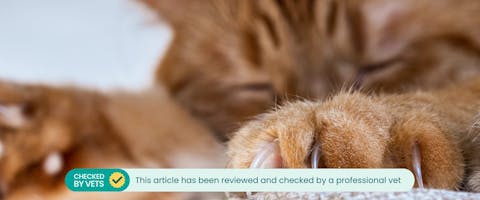Updated 21/02/2024
If you haven’t heard of cat-horned paws, this may conjure the image of your kitty sprouting large dragon talons from their murder mittens. Luckily, a cat-horned paw isn’t anywhere near as scary or bizarre, in fact, it’s actually quite common.
We’re all about the toe pads and toe beans today, so let’s find out a bit more about what cat-horned paws are, what causes a horned paw, how to spot one, and the course of treatment your vet may recommend.
Trending posts
Purr-use some of the top blogs our members have been loving this month- Top male dog names for your new furry friendGot a new furry family member in your pack? Check…

- Top female dog names for your new fluffy palWelcoming a new pooch into your family? Explore…

- 250+ gray cat names your silver feline will loveRecently welcomed a fluffy gray bundle of joy into…

- What are normal pet sitting rates?Discover the average pet sitting rates for animals…

- Unique dog names to stand out from the packDare to be different with our list of the best…

What are cat-horned paws?
The veterinary diagnosis for a cat-horned paw is a cutaneous horn cat paw. Horned paws are found as a growth on a weight-bearing part of the paw, so most often the large, central paw pad AKA the cat carpal pad (if you want to be scientific and sound official). Generally, they’re pretty harmless to most kitties and don’t cause them any pain. However, always keep an eye on the horned paw’s growth, and be sure to let your vet know of any changes. Similarly, if you notice your cat overly grooming their paw, limping, or refusing to put weight on it, take them straight to the vet.
The cause of a cat-horned paw
We all know how busy cats are between their 16 hours of sleeping a day. If you have a particularly active purr baby, their paw pads will toughen from more wear and tear, which is completely normal. Sometimes, this paw toughening can lead to an extra build-up of paw skin - also called cat hyperkeratosis - which can then form a cat-horned paw.
Other causes can include previous injuries that have formed scar or cystic tissues, or occasionally cutaneous horns can be associated with some viruses, including feline leukemia (FeLV) and papillomavirus. Rarely, a type of cancer called squamous cell carcinoma can form little growths surrounded by scaly skin which look similar to cat horns. If you notice your cat has a horned paw, always take them to the vet, even if it doesn’t appear to be causing them any issues.
What is cat hyperkeratosis?
Hyperkeratosis can be found in many different mammals, including humans. Cat hyperkeratosis is when a kitty’s body makes too much keratin - the stuff their claws and fur or human hairs and nails are made from - causing hardened skin to build up, i.e. a cat-horned paw. As cat hyperkeratosis can be found anywhere on a feline’s body, it’s more a cause for a horned paw rather than the actual name of the condition.
How to spot a cat horned paw
Cat paws are generally either pink, black, or a mixture of both, or they even have a few splodges of brown thrown in. They’re unique to each fluff fiend and pet parents are often quite familiar with how they usually look. I mean, who doesn’t love toe beans? So, if you notice an extra piece of paw appear that is hardened and thicker than the paw pad, you have yourself a cat-horned paw! These can appear anywhere on the paw, but they’re most commonly found on the center pad. If you suddenly start hearing a new clicking sound come from your cat as they walk, this could also be a sign.
Don’t confuse this with an extra toe bean, or polydactyl cat toe. This is where a kitty is born with an extra toe or two and causes no issues or harm to your fur family.
Treating a horned paw cat
Luckily, this is a relatively easy one for vets to treat, as says veterinary cat expert Dr. Karyn Kanowski:
“In most cases, cutaneous horns do not require treatment, but if they grow quite long, they can be trimmed in much the same way as a nail would be. The horns associated with FeLV are a bit trickier to treat due to their location in the center of the pad, but if needed, can be trimmed, filed, or surgically removed or debulked.
It is always best to take your cat for an examination at the vet to confirm the diagnosis, look for other underlying conditions, and decide on the best course of treatment.”
Be sure to mention if your feline family is showing any signs of discomfort, pain, or reduced mobility. This will help your vet to decide what the best treatment will be.
Meet our veterinary expert, Lizzie
This article has been checked by veterinarian Lizzie Youens BSc (Hons) BVSc MRCVS. Lizzie graduated from the University of Bristol in 2011, and has been working in first opinion companion animal practice. She has worked in a variety of clinics across the UK, from large hospitals to small branch practices. She enjoys doing a mixture of medicine, surgery and emergency work. Lizzie currently works in a small rural practice where she enjoys working in a close-knit community.
If you’re already a TrustedHousesitters Standard or Premium member, you have 24/7 access to our vet advice line, even over the holidays. Always contact a vet if you ever have any concerns about cat safety. Not a member yet? Well, have a look at our lovely pricing options for Sitters, Pet Parents, or both!

